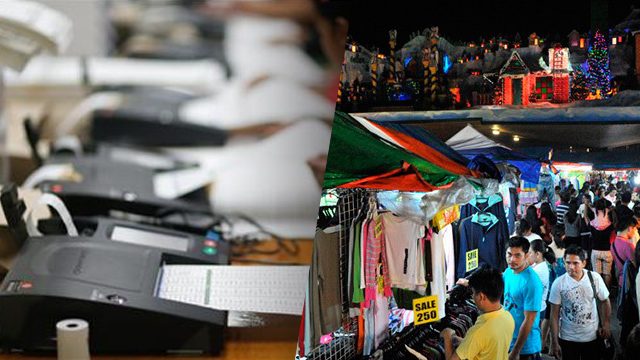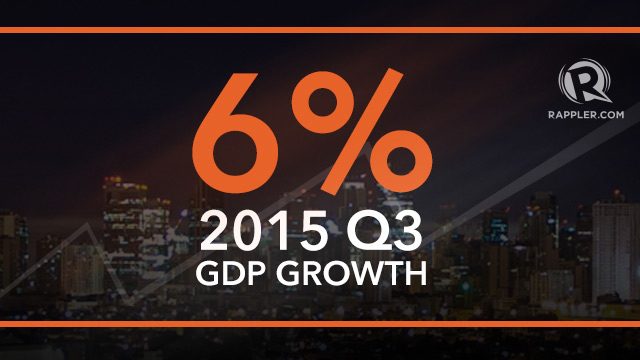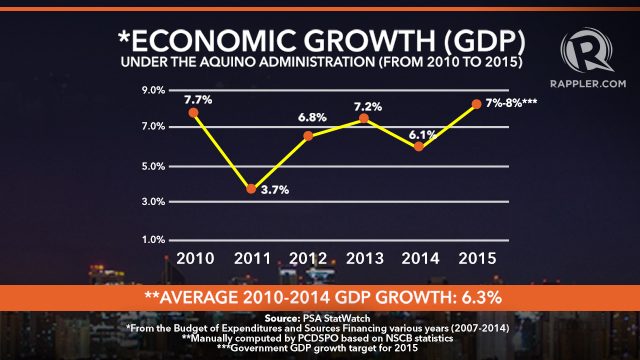SUMMARY
This is AI generated summarization, which may have errors. For context, always refer to the full article.

MANILA, Philippines (UPDATED) – With the year practically over, economists see Philippine economic growth falling below target. (READ: PH GDP grows 6% in Q3)
Although the expected surge in overseas Filipino workers (OFW) remittances, stronger infrastructure spending, as well as the coming holiday and elections spending are seen to further boost the gross domestic product (GDP) growth in the fourth quarter, the Philippines will have a hard time hitting 6% growth, some economists said.
Their remarks came a few minutes after the Philippine Statistics Authority (PSA) on Thursday, November 26, announced that the nation’s GDP expanded 6% in the July-September quarter from a year earlier – higher than the revised 5.8% in the second quarter.
With 9-month growth at 5.6%, a 6% full-year growth is very much likely, given even better prospects for the last quarter, socio-economic planning chief Arsenio Balisacan said during a media briefing.
Balisacan said the country needs to grow by 6.9% in the fourth quarter to reach a full-year growth of 6%. (READ: Second half will be better – economists)
Its 7%-8% growth target for 2015, however, is out of reach.

Even 6% is unlikely
But for Benjamin Diokno, University of the Philippines (UP) economist and former budget secretary, the 6% GDP growth for 2015 is even unlikely.
“For the first 3 quarters, GDP growth averaged 5.6%. Assuming the economy can grow by 6.9% in the fourth quarter – an assumption that is possible but not likely – then the full-year GDP growth would be 5.925%,” Diokno said in a text message.
Diokno’s computation is slightly less than Balisacan’s 6% full-year GDP growth forecast. (READ: PH to miss 2015 GDP growth target – economists)
“Given the economy’s performance in the first half of the year, I have forecasted that the economy would grow by 5.9%. With GDP growth of 6% in the third quarter, my forecast is still doable though highly improbable,” Diokno added.
With the final quarter almost over, agriculture and exports are showing downward signs, retail sales are tepid, and government spending is still below program, Diokno said.
His remarks were echoed by Asian Institute of Management (AIM) economist Emmanuel Leyco, saying that even the 6% full-year growth estimate of the government is unachievable.
“The [third quarter growth of] 6% is good. I also think that 6.9% target for fourth quarter is unachievable, as services sector as a major driver already grew 7.3% – which may be difficult to exceed in the fourth quarter,” Leyco said in a text message.
Accounting for half of the country’s GDP, the services sector expanded 7.3% in the third quarter. The industry sector, meanwhile, gained 5.4% on year.
Agriculture, an employer of more than 3 of every 10 Filipinos, only inched up 0.4% last quarter.
For Alvin Ang, economics professor at the Ateneo de Manila University, “the government’s target of 6.9% for the last quarter is on the high side but achievable.”
“Our fourth quarter target is about 6.5%, bringing full-year growth to 6%. Same risks and drivers with NEDA, but with different magnitude,” Ang said in a text message.
“In our view, the key risks to growth continue to stem from weaker external demand and adverse weather conditions, though inflation has remained manageable,” Barclays analyst Rahul Bajoria said.
Credit Suisse analyst Michael Wan said the Philippines had fiscal and monetary policy space to respond to a potential regional growth slowdown given its lesser exposure to China compared to its neighbours.
Wan hailed the country for strong overall performance, including a boost in consumption and a pick up in spending.
“The Philippines remains one of the best macro stories in the region,” Wan said.

APEC spending
Low inflation, cheap oil prices, higher infrastructure spending, and the anticipated effects of election and holiday spending on GDP will help the country record faster growth in the fourth quarter.
Private consumption, fueled by a steady growth in overseas workers remittances, was up 6.3% on year, while government spending increased 17.4% on year.
For John Paolo Rivera, an independent economic consultant, the 6% economic growth last quarter is “below expectations but acceptable.”
“The fourth quarter target growth of 6.9% is feasible as a consequence of the Asia-Pacific Economic Cooperation (APEC) spending,” Rivera said.
The government earlier said that it spent around P10 billion for the APEC meet here in Manila. (READ: APEC led to losses for hotels, airlines)
“The APEC spending may be the main driver, accompanied by ongoing infrastructure spending and the surge of remittances due to Christmas season,” Rivera said.
Rivera added that he expects an about 6% GDP growth for 2015 induced by private consumption spending. – with a report from Agence-France Presse/Rappler.com
Add a comment
How does this make you feel?
There are no comments yet. Add your comment to start the conversation.